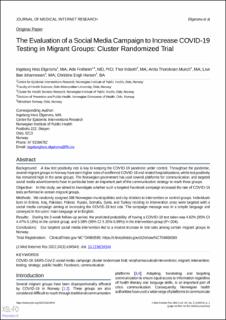| dc.contributor.author | Elgersma, Ingeborg Hess | |
| dc.contributor.author | Fretheim, Atle | |
| dc.contributor.author | Indseth, Thor | |
| dc.contributor.author | Munch, Anita Thorolvsen | |
| dc.contributor.author | Johannessen, Live Bøe | |
| dc.contributor.author | Hansen, Christine Engh | |
| dc.date.accessioned | 2022-08-10T13:17:16Z | |
| dc.date.available | 2022-08-10T13:17:16Z | |
| dc.date.created | 2022-04-19T18:55:54Z | |
| dc.date.issued | 2022-03-24 | |
| dc.identifier.citation | Journal of Medical Internet Research. 2022, 24 (3), . | en_US |
| dc.identifier.issn | 1438-8871 | |
| dc.identifier.uri | https://hdl.handle.net/11250/3011151 | |
| dc.description.abstract | Background: A low test positivity rate is key to keeping the COVID-19 pandemic under control. Throughout the pandemic, several migrant groups in Norway have seen higher rates of confirmed COVID-19 and related hospitalizations, while test positivity has remained high in the same groups. The Norwegian government has used several platforms for communication, and targeted social media advertisements have in particular been an important part of the communication strategy to reach these groups.
Objective: In this study, we aimed to investigate whether such a targeted Facebook campaign increased the rate of COVID-19 tests performed in certain migrant groups.
Methods: We randomly assigned 386 Norwegian municipalities and city districts to intervention or control groups. Individuals born in Eritrea, Iraq, Pakistan, Poland, Russia, Somalia, Syria, and Turkey residing in intervention areas were targeted with a social media campaign aiming at increasing the COVID-19 test rate. The campaign message was in a simple language and conveyed in the users’ main language or in English.
Results: During the 2-week follow-up period, the predicted probability of having a COVID-19 test taken was 4.82% (95% CI 4.47%-5.18%) in the control group, and 5.58% (95% CI 5.20%-5.99%) in the intervention group (P=.004).
Conclusions: Our targeted social media intervention led to a modest increase in test rates among certain migrant groups in Norway. | en_US |
| dc.language.iso | eng | en_US |
| dc.publisher | JMIR Publications | en_US |
| dc.relation.ispartofseries | Journal of Medical Internet Research;Vol 24, No 3 (2022): March | |
| dc.rights | Navngivelse 4.0 Internasjonal | * |
| dc.rights.uri | http://creativecommons.org/licenses/by/4.0/deed.no | * |
| dc.subject | COVID-19 | en_US |
| dc.subject | SARS-CoV-2 | en_US |
| dc.subject | Social media | en_US |
| dc.subject | Cluster randomized trials | en_US |
| dc.subject | Nonpharmaceutical interventions | en_US |
| dc.subject | Migrants | en_US |
| dc.subject | Public health | en_US |
| dc.subject | Testing | en_US |
| dc.title | The Evaluation of a Social Media Campaign to Increase COVID-19 Testing in Migrant Groups: Cluster Randomized Trial | en_US |
| dc.type | Peer reviewed | en_US |
| dc.type | Journal article | en_US |
| dc.description.version | publishedVersion | en_US |
| dc.rights.holder | © Ingeborg Hess Elgersma, Atle Fretheim, Thor Indseth, Anita Thorolvsen Munch, Live Bøe Johannessen, Christine Engh Hansen | en_US |
| dc.source.articlenumber | e34544 | en_US |
| cristin.ispublished | true | |
| cristin.fulltext | original | |
| cristin.qualitycode | 2 | |
| dc.identifier.doi | https://doi.org/10.2196/34544 | |
| dc.identifier.cristin | 2017693 | |
| dc.source.journal | Journal of Medical Internet Research | en_US |
| dc.source.volume | 24 | en_US |
| dc.source.issue | 3 | en_US |
| dc.source.pagenumber | 1-10 | en_US |

